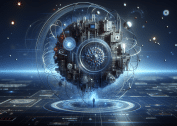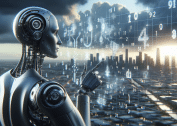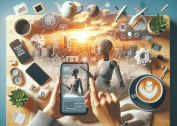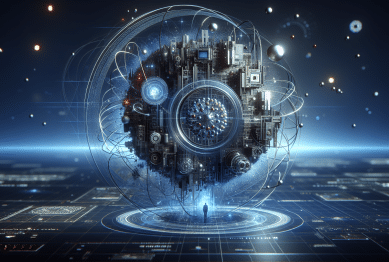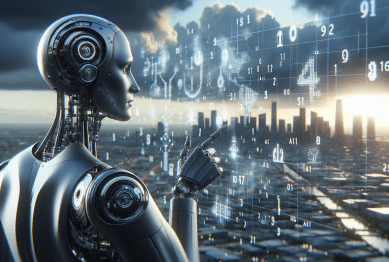Artificial intelligence isn’t some distant future. It shapes how people work, communicate, and solve problems right now. This guide explores the rise of AI, how machine learning is integrated into everyday tech, and what these advancements mean for you in practical ways.
The Explosion of Artificial Intelligence in Daily Life
Artificial intelligence (AI) now touches nearly every corner of daily experience. It powers online searches, curates what people see in social media feeds, and even streamlines online customer support with responsive chatbots. Take smart assistants as an example. These tools analyze your voice, process natural language, and respond instantly — all thanks to rapid advancements in machine learning and data science. Whether searching for a map or streaming a playlist, AI is the invisible force making it seamless.
This widespread adoption happened quickly for a reason. Advances in big data processing, cloud computing, and innovative neural networks gave companies the push needed to deploy AI at scale. As a result, technology is now able to offer recommendations adapted to individual preferences, making digital interactions feel more human. Supervised learning models train on extensive datasets to recognize faces, understand text, and translate different languages. These systems grow smarter every time they process new information, which is exactly why many people feel technology now ‘knows’ them.
People might be surprised to realize AI goes far beyond just apps and internet tools. In cities, AI manages traffic patterns; in healthcare, it helps flag diseases in early screening; in smart homes, energy use is optimized. The digital world is changing rapidly, and artificial intelligence will continue to evolve, bringing more personalized and intelligent solutions across industries (Source: https://www.nsf.gov/news/special_reports/ai/).
The Core Technologies Making AI Possible
The magic at the core of artificial intelligence is machine learning — a powerful process where computers learn from enormous data sets. Instead of being programmed for every possible scenario, these systems identify patterns and adapt on their own. Deep learning, which uses multi-layered neural networks, has led to striking breakthroughs in voice recognition and image analysis. That’s why your smartphone can tag people in photos or transcribe messages with impressive accuracy.
Reinforcement learning is also making waves. This method uses a trial-and-error approach, allowing software to learn optimal strategies in dynamic situations, like mastering complex games or teaching robots to navigate unfamiliar environments. When these strategies combine with cloud computing, businesses can analyze and act on real-time information at a global scale. The marriage of hardware improvements, open-source datasets, and smart algorithms accelerates rapid innovation (Source: https://deepai.org/machine-learning-glossary-and-terms/).
The integration of AI technology in consumer devices is also driven by advances in sensor technology and data connectivity. Voice assistants leverage microphones and speakers, while health trackers rely on biosensors and motion detectors. Each interaction produces valuable data, which is in turn fed back into the AI system for constant refinement. That is why users notice their gadgets getting smarter over time, adapting to their habits and preferences.
Everyday Examples: Where AI Is Working for You
Think of how recommendation engines suggest music, shows, and products tailored to your tastes. Personalized streaming is possible because machine learning algorithms learn from past choices, quick likes, and even listening times. Retailers use similar technology to show items you might need before you even realize it. These experiences feel intuitive because AI quietly blends into familiar interfaces, enhancing the customer journey without users having to think about it.
Email spam filters, fraud detection in banking, and predictive text are all examples of AI in action. Automatic translation tools break down barriers for international communication, while virtual assistants help schedule meetings and answer questions. In healthcare, AI-driven apps monitor symptoms and remind patients to take their medication. Machine learning’s use in diagnostic algorithms is helping doctors make better, faster decisions (Source: https://www.nih.gov/news-events/news-releases/nih-funds-research-use-artificial-intelligence-diagnose-predict-diseases/).
Even smart cities and public safety benefit from intelligent video analysis, traffic control, and energy grid optimization. Applications monitor crowds, flag potential safety issues, and react in real time. From unlocking phones with a glance to receiving curated news in social feeds, AI tools are always listening and learning. These tools help people save time, improve safety, and enjoy more convenient interactions almost invisibly.
The Data Behind Smart Technology
Everything AI touches begins with data. Large quantities of information are collected, sorted, and analyzed to reveal insights. For instance, chatbots learn from thousands of real conversations to better predict what a user needs next. This process, known as training, lets AI adapt to slang, sentiment, and context, resulting in more natural interactions. The sheer scale of this data enables the most sophisticated solutions — from autonomous vehicles to virtual personal advisors (Source: https://www.nist.gov/artificial-intelligence).
Yet, the use of massive datasets also raises privacy and ethical questions. Personal information gets anonymized and encrypted, but concerns remain about how companies use and protect sensitive data. Consumers should know the basics of digital footprints, since every online interaction, from a web search to a device location ping, contributes to machine learning models and service personalization. Transparency and good practices are becoming the gold standard in AI use, driving the need for tech companies to prioritize user trust.
On the positive side, access to anonymized, aggregated data empowers breakthroughs for society — allowing for better urban planning, healthcare research, and climate modeling. Civic data platforms, for example, inform communities and policymakers. When managed responsibly, big data fuels lifesaving technologies and smarter public services. The key lies in balancing innovation with ethical stewardship, building tech that benefits rather than exploits (Source: https://datascience.nih.gov/bios/).
Opportunities and Concerns for the Future
As AI continues to advance, the technology brings both new opportunities and important challenges. Automation enhances efficiency across sectors, reshapes traditional jobs, and opens entirely new career fields. There’s surging interest in AI literacy, with universities and online platforms offering specialized courses for those interested in the field. The growth of AI ethics, policy, and governance studies points to society’s recognition of both its power and responsibility (Source: https://ocw.mit.edu/courses/media-arts-and-sciences/mas-s60-innovations-in-education-artificial-intelligence-and-social-robotics/).
One growing area is explainable AI. Developers are working to create systems that don’t simply provide answers but also explain the rationale behind them. As more decisions get handed off to intelligent systems, knowing the logic behind outcomes ensures fairness and accountability. Education about potential biases, algorithm transparency, and responsible adoption are crucial to keeping advances in line with real human needs. Ongoing research explores how these technologies can be evaluated, tested, and improved for social good.
There’s plenty of excitement about what’s next — from self-learning robots to advanced conversational agents. Still, responsible use and critical evaluation remain vital. Understanding the strengths and limits of AI allows people to harness its benefits while minimizing risks. Society’s challenge is to shape technologies that uplift, empower, and connect, while maintaining security and trust for all users.
Practical Tips for Navigating the AI-Powered World
It’s easier than ever to encounter AI technologies in work, leisure, and daily routines. To remain informed, consider following developments in artificial intelligence directly through reputable educational resources, online platforms, and nonprofit organizations. The more users understand about machine learning, the better equipped they’ll be to make informed choices about privacy, security, and getting the most from digital tools (Source: https://www.khanacademy.org/computing/computer-science/ai).
Users should periodically review device settings for privacy controls and familiarize themselves with permissions on their favorite platforms. Comparing different services and reading transparency reports from major technology companies can offer deeper insights. Be mindful that not all platforms handle data and personalization in the same way. Taking advantage of free educational courses on AI basics, data security, and ethical considerations can be both empowering and practical for anyone interested in tech’s evolution.
Embracing curiosity and lifelong learning prepares people to adapt as technologies shift. Seek out trusted advisors, participate in online workshops, and ask questions whenever something isn’t clear. People who understand the capabilities and limits of machine learning will find themselves at a tremendous advantage — not just using technology, but helping guide its growth for the greater good.
References
1. National Science Foundation. (n.d.). Artificial Intelligence. Retrieved from https://www.nsf.gov/news/special_reports/ai/
2. DeepAI. (n.d.). Machine Learning Glossary and Terms. Retrieved from https://deepai.org/machine-learning-glossary-and-terms/
3. National Institutes of Health. (n.d.). NIH Funds Research to Use AI to Diagnose, Predict Diseases. Retrieved from https://www.nih.gov/news-events/news-releases/nih-funds-research-use-artificial-intelligence-diagnose-predict-diseases/
4. National Institute of Standards and Technology. (n.d.). Artificial Intelligence. Retrieved from https://www.nist.gov/artificial-intelligence
5. National Institutes of Health Office of Data Science Strategy. (n.d.). BIOS Data Science. Retrieved from https://datascience.nih.gov/bios/
6. MIT OpenCourseWare. (n.d.). Innovations in Education: Artificial Intelligence and Social Robotics. Retrieved from https://ocw.mit.edu/courses/media-arts-and-sciences/mas-s60-innovations-in-education-artificial-intelligence-and-social-robotics/



